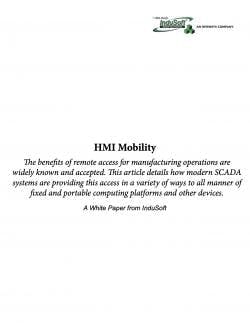Human Machine Interface (HMI) has evolved significantly from the days in which operations staff had to sit in front of a single screen to monitor a machine or a process. HMI /SCADA (Supervisory Control and Data Acquisition) applications now not only monitor and help control equipment and processes, but also provide a huge range of information regarding machine and plant operations. Since many people consider HMI to be a low-end panel-mounted apparatus, the term SCADA will be used to refer to the more advanced applications discussed in this article.
Table 1 lists the various ways in which HMI and SCADA systems provide remote access to users. At the most basic, a panel-mounted HMI with built-in web server capabilities provides some limited degree of remote access via a web browser. This access is often only one-way, allowing remote users to view information, but not to make changes.
The next step up is again server-browser access, but this time via local SCADA software, generally running on a PC installed locally at the machine or the process. Although the remote access is still via browser, in most cases this access is more full-featured than with a simple HMI, allowing remote users to view more information in a wider variety of formats. SCADA server-browser access also usually provides two-way access, allowing for remote adjustments and corrections


